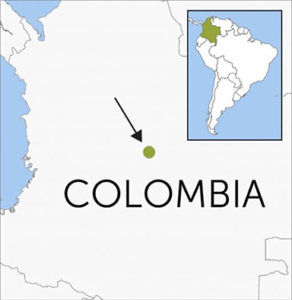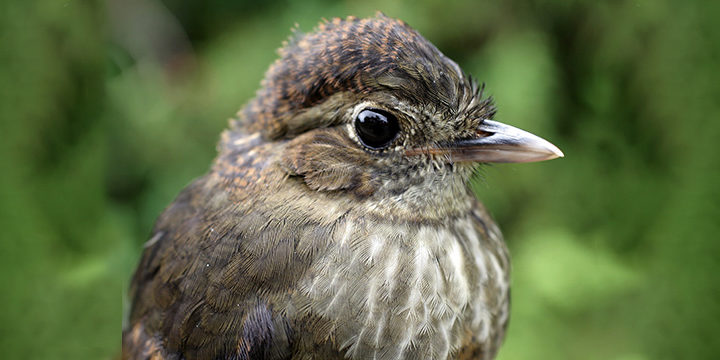Bird of The Week: Cundinamarca Antpitta
Scientific Name: Grallaria kaestneri
Population: 330-800
IUCN Status: Endangered
Trend: Decreasing
Habitat: Highland cloud forest.
About the Cundinamarca Antpitta
The leggy Cundinamarca Antpitta inhabits misty highland cloud forest, lush habitat it shares with many other birds, including the Grass-green Tanager, Blackburnian Warbler (in winter), and the Chestnut-crowned Antpitta. Although seldom seen, this bird clearly advertises its presence with a distinct and resonant “Fuit Foh Feer” song. Yet this distinctive vocalization did not turn ears until top world birder Peter Kaestner heard it on October 16, 1989. His curiosity piqued, Kaestner taped the song, then played it back. Forty-five minutes later, a mid-sized bird hopped into view with a combination of field marks unlike other Colombian antpittas — a white throat, grayish underparts streaked thinly with white, and an olive-brown back. In 1992, the species was officially recognized. Kaestner was honored for his find in the species’ scientific name: Grallaria kaestneri. Deforestation has transformed the area where the Cundinamarca Antpitta was first located, and this Endangered bird’s future remains uncertain.
An Antpitta Safe Haven
In 2022, ABC joined with Colombian partner Fundación Camaná and a local family to help set up a reserve for the Cundinamarca Antpitta, and to boost an already-existing ecotourism venue that draws visitors to support local conservation efforts. The next year they realized this goal: the purchase of four properties totaling 446 acres to create the Reserva Refugio Tororoi (the local word for antpitta), located southeast of Bogotá. The new reserve is also home to the Sickle-winged Guan, Lined Quail-Dove, Black-and-chestnut Eagle (Endangered), Broad-winged Hawk (winter), Brown-breasted Parakeet (Vulnerable), Southern Emerald-Toucanet, Long-tailed Sylph (a hummingbird), Long-tailed Tapaculo, Ochre-breasted and Slaty Brushfinches, and more than 300 other bird species.
Breeding and Feeding
Grounded and Poorly Known
Based on when this bird sings, ornithologists believe the Cundinamarca Antpitta’s breeding season occurs well into the rainy season, between September and November. Little else is currently known of the species’ breeding behavior. Other antpittas in the genus Grallaria construct bulky open-cup nests made of sticks, leaves, stalks, vines, rootlets, and other plant matter, placed on stumps, logs, or branch forks or intersections, often just a few feet off the ground.
The Cundinamarca Antpitta spends most of its time on the ground, though on occasion it sings from low perches. While foraging, it hops from place to place, stopping now and then to shuffle leaf litter with its bill. Its quarry is terrestrial invertebrates, including beetles, katydids, spiders, and earthworms. The bird sometimes batters prey against the ground or vegetation before consuming it.
Region and Range
 The Cundinamarca Antpitta is endemic to Colombia and only found in wet montane forest with thick understory within a small region along the Andes’ eastern slope, southeast of Bogotá. It was first described in secondary forest at around 7,000 feet elevation.
The Cundinamarca Antpitta is endemic to Colombia and only found in wet montane forest with thick understory within a small region along the Andes’ eastern slope, southeast of Bogotá. It was first described in secondary forest at around 7,000 feet elevation.
Conservation
As with another Colombian endemic, the Antioquia Brushfinch, the main threat facing the Cundinamarca Antpitta is habitat loss. Conserving the right amount of habitat is key to ensuring a bright future for localized endemics like this bird.
As previously mentioned, ABC and its Colombian partner Fundación Camaná recently established a reserve for this species. There, worm feeding stations bring the antpittas within regular view of visitors, helping raise awareness and attention to the species and reserve, as has been done with the Jocotoco Antpitta and other species in Ecuador. The recently acquired 446-acre reserve adjoins other national and regional conservation areas, providing contiguous habitat for the antpitta and a wide range of other cloud-forest species.
Get Involved
Many of the rarest bird species in the Western Hemisphere remain relatively unknown. You can learn more about these birds and the threats they face by signing up for ABC’s Bird of the Week email series, which frequently highlights these fascinating birds.
American Bird Conservancy and our partners throughout Latin America and the Caribbean have created and expanded more than 100 bird reserves, which protect upward of 1.1 million acres of vital habitat. Together, we’ve planted more than 6.8 million trees, helping to restore degraded and damaged habitat. You can help us continue to protect endangered birds by making a gift today.
Source: American Bird Conservancy (abcbirds.org)


